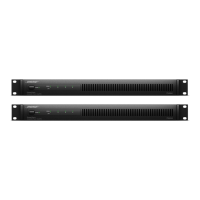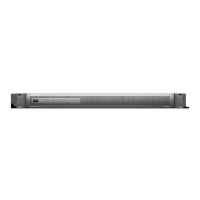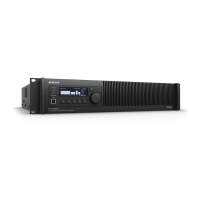112
TEST PROCEDURES
5.4 Measure the output level at the channel
1 - 4 outputs. Adjust the input level to attain
an output of 100W from both channels.
5.5 Measure the THD+N level at the channel
1 - 4 outputs. It should be < 0.1%.
6. Frequency Response and Noise Test
6.1 Set the Output 1 and 2 DIP switches
to Low-Z mode (right). Set the GLOBAL
OUT DIP switch to 70V (left). Set the
SENSITIVITY DIP switch to 4 dBu (left).
6.2 Connect 4 Ohm, 300 W loads to the
channel 1 and 2 outputs.
6.3 Apply a 1 kHz, -19.3 dBV input to the
channel 1 - 4 inputs.
6.4 Measure the output level at the channel
1 - 4 outputs. Decrease the input level to
attain an output of 1W from all channels.
Change the dB meter scale to dBr. Refer-
ence a dB meter to the output level.
6.5 Change the input frequency to 20 Hz.
Measure the output level. It should be
0 dBr +/- 1.0 dB.
6.6 Change the input frequency to 20 kHz.
Measure the output level. It should be
0 dBr +/- 1.0 dB.
6.7 Turn off the signal generator.
6.8 Set the Output 1 - 4 DIP switches to Hi-Z
mode (left). Set the GLOBAL OUT DIP
switch to 100V (right).
6.9 Measure the output noise level using a
20 kHz filter and A-weighting. It should be
< -57 dBV for all inputs.
7. Signal LED Test
7.1 Apply a -50.2 dBV +/- 2 dBV, 1 kHz sine
wave to the channel 1 - 4 EURO BLOCK
connectors. Verify that the SIGNAL LED
lights GREEN.
7.2 Change the input level to +6.8 dBV +/- 2
dBV. Verify that the SIGNAL LED lights AM-
BER.
7.3 Change the input level to +9.8 dBV +/- 2
dBV. Verify that the SIGNAL LED lights RED.
8. Limit LED Test
8.1 Apply a + 2.0 dBV +/- 2 dBV, 1 kHz sine
wave to the channel 1 - 4 EURO BLOCK
connectors. Verify that the LIMIT LED lights
AMBER.
9. Crosstalk Test
9.1 Set the Output 1 - 4 DIP switches to Hi-Z
mode (left). Set the GLOBAL OUT DIP switch
to 100V (right). Set the SENSITIVITY DIP
switch to 4 dBu (left). All other DIP switches
should be set to the left.
9.2 Connect 32 Ohm, 300 W loads to the
channel 1 - 4 outputs.
9.3 Using a 20 Hz to 20 kHz filter, apply a
1 kHz, -19.3 dBV input to the channel 1
input jack.
9.4 Adjust the input signal level to get a
100 W output at the channel 1 output.
9.5 With the above input applied to the chan-
nel 1 input, measure the output level at the
channel 2, 3 and 4 outputs. It should be
> -70 dB.
9.6 Change the input frequency to 20 kHz.
Measure the output level at the channel 2, 3
and 4 outputs. It should be > -55 dB.
9.7 Repeat steps 9.3 to 9.6 for the channel
2, 3 and 4 inputs.
10. Output Gain Control Range Test
10.1 Set the Output 1 - 4 DIP switches to
Hi-Z mode (left). Set the GLOBAL OUT DIP
switch to 100V (right). Set the SENSITIVITY
DIP switch to 4 dBu (left).

